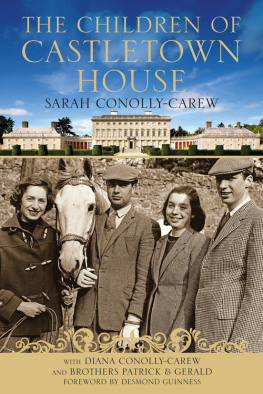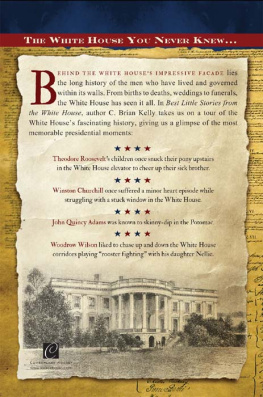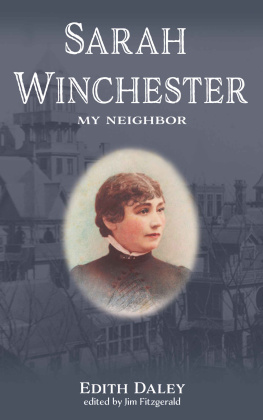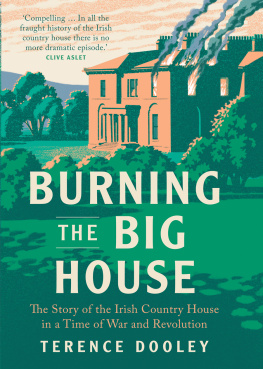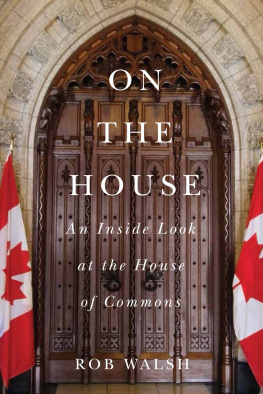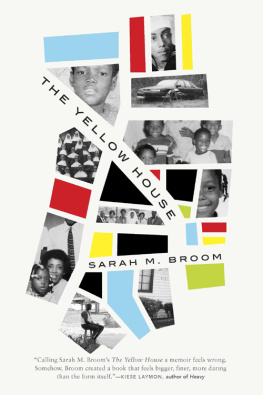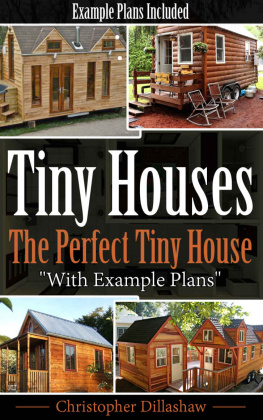
To our parents,
from all four families'
children, grandchildren,
and great-grandchildren
My ambition was always for Castletown to relate its own story. I wanted a visitor to walk in the front door, and be able to step in amongst our cast of characters, to relive the legends, the fame, and secret family memories waiting to be told around every nook and cranny. I believe these unique untold stories will people our historic house But read the book first!
In order for this ambitious project to come to fruition, we have needed many helpers. It has taken years of planning, digging up memories, mountains of old and new research, talking to the families of our old helpers, and of course the writing.
The main body of work has been researched (with miles of notes) by my extraordinary, clever big sister Diana Conolly-Carew. Without her memories and stories, there would be no book. Our brothers Patrick and Bunny have contributed, encouraged and supported all our efforts.
We have so many others to thank for their advice, support, and help, especially Charles Lysaght and Rose Angela Barone, our original planning and layout advisers.
Back in 1964, Deirdre Guinness (Mrs Egerton Skipwith) was my personal photographer, taking over 400 unique images of both the interiors and exteriors, in order to capture what Castletown looked like while we still lived there (with this book in mind).
I have had exceptional extra research help from Catherine Boylan, on behalf of her mother and historian, the late Lena Boylan; John R. Dungan MD, for help with the old castle Dongan Papers; Donough McGillycuddy, for his letters to Diana; Harry McDowell, for invaluable help and support; April Mervelt, for her stories of our times; Brough Scott, for his permission to quote from his book on his grandfather, Jack Seeley; Michael Slavin, for a wonderful supply of books for my research; Chris Shaw, for older family photographs of our grandmother Catherine Conollys time; and Carmel Locke, who has been my chief fixer and finder of long lost books, articles, and photographs.
We thank Victoria Browne for invaluable help with old Castletown furniture; Desmond Guinness for his Foreword, and for checking through the manuscript; Patrick Guinness for his view of the old Guinness butler at Castletown; Prof. Dooley, for pointing us towards our publishers; and Ronan Colgan and Beth Amphlett with their team at The History Press Ireland for their help and guidance.
We also wish to thank: Margaret Cummins, Anna Darragh, Mr & Mrs Aidan Kelly, Michael Kenney, Mrs Lawless, Sir George Locke, Helen McDonald, David Mercier, James Murphy, Dr Pdraig Snodaigh, Johnny ONeill, Tony Power, Susan Pegley, Mrs Bob Smith, Audrey Smith, Ann Stoney, and Patrick Walsh for everything.
Separately, we wish to thank Claire Hickey and all the staff of the Office of Public Works, who are responsible for Castletown now; as well as Members of the Castletown Foundation.
Lastly, I could not have written this book without the constant support and encouragement of my husband Ian Macpherson, who is my editor here.
C ONTENTS
It would be very hard to over-estimate the importance of this book. It mainly covers the uncharted years of the authors' family and Castletown in the twentieth century, with all the highs and lows that accompanied them.
Sally Conolly-Carew, with the help of her brothers and sister, has painted a marvellous picture of what it was like to grow up at Castletown, with the stables full of horses and the garden and greenhouses flourishing, all playing their own important role. She also makes us fully aware of the appalling difficulties that led to her fathers reluctant decision to sell. Little did I think that in years to come I would find myself buying the empty house to save it from vandalism.
In 1956, soon after I married, we rented Carton from Lord Brocket as a base to find a farm for ourselves. It is about 4 miles from Castletown as the crow flies and was built in 1739 by the FitzGeralds, Earls of Kildare and later Dukes of Leinster. Midway stands by the 140ft high Conolly Folly, an obelisk built on Carton land in 1740 by the Conollys, to give employment during the Great Famine.
I shall never forget the excitement of the first time we went to dinner with Lord and Lady Carew. The governess, Miss Colls, came down the magnificent staircase in full evening dress and a fur coat! The evening was full of fun and laughter; it also helped to fuel my growing passion for architecture. My other passion was hunting, and it was not long before Diana Conolly-Carew and myself were joint masters of the North Kildare Harriers, and I was lucky enough to compete with her in cross-country events.
Sallys beautifully written memories bring those far-off days to life and make them seem like yesterday. We have a lot to thank her for.
Desmond Guinness
February 2012
Invitation to Join Us

Sensing the Past
Being the eighth and last generation of Conollys who have lived at Castletown, we are surrounded with the memories of our years growing up as Conolly-Carew children. In this book we have tried to look back on those magnificent days as best we can; days of Grand Balls, tiaras, titles, and etiquette; of prancing horses, carriages, early cars, and donkeys, which all carried the great (and often eccentric) people to receptions, dinner parties, and balls. We look at the passing of a bygone age, and ultimately, the latter-day struggle of our parents to keep the house going.
But, above all, we want to tell you of the fun we had from day to day, and what life was like in those different days of servant and master, when our world was gently gilded by that inexplicable bond between an Irishman and his horse. These are the halcyon days that we would like to share with you. All is changed now, of course for instance, our much-loved butlers granddaughter is now a Princess.

In 1938, Sylvia Carew (our mother) was the third newly married wife to take up residence during Castletowns 200-year-old history. She was treading in the footsteps of Lady Louisa Conolly, great granddaughter of King Charles II, who created the decorations in the house, and who had cut the walks and rides we loved, dotted with temples, lovers byres, tea houses, and the Great Wood.
If Mother knew nothing of the colourful stories of the past, the secret castle, the gold and vermillion state coach of Speaker Conolly jangling up the front avenue, the Devil in the dining room, and how parts of the house fell down when it was first built, she could not possibly have known what the future held
And perhaps this was just as well. Perhaps it was just as well not to know of the years ahead, when a servants hand that would reach out of the window to hide the silver in the basement hedge; the IRA hand that threatened the gun on us all; the handmade donkey cart, and the smoking gas-cars of the elite; the pranksters who painted the statues red in tender places; the naked grave robber; the lifeless hand of a dead butler at a Hunt Ball; the hands of lovers and trespassers climbing through the windows of the house.
How could she have known that one day, her mother (a Dowager Countess) would get down on her hands and knees to scrub the floor of the famously decorated Long Gallery? Or that a society tailor would come to watch his clothes dancing at the Ball? That loving relatives would open a coffin, only to find it full of bottles? How a barge-horse from the local canal would make her eldest son famous?
Next page
